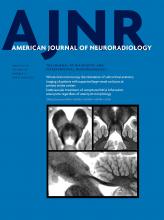Abstract
BACKGROUND AND PURPOSE: Midnasal stenosis is a poorly defined entity that may be a component of other conditions of nasal obstruction contributing to respiratory distress in infants. We sought to establish whether midnasal vault narrowing is a component of well-defined syndromes of nasal narrowing, such as bilateral choanal atresia and pyriform aperture stenosis, and to characterize the nasal anatomy of patients with syndromic craniosynostosis.
MATERIALS AND METHODS: A convenience sample of patients with pyriform aperture stenosis, bilateral choanal atresia, and Apert and Crouzon syndromes with maxillofacial CT scans was identified. Patients with Pierre Robin Sequence were used as controls. Nasal measurements were performed at the pyriform aperture, choana, and defined midnasal points on axial and coronal CT scans. Intra- and interrater reliability was quantified with the intraclass correlation coefficient. T tests with Bonferroni adjustment were used to assess differences from controls.
RESULTS: The study included 50 patients: Eleven had pyriform aperture stenosis, 10 had Apert and Crouzon syndromes, 9 had choanal atresia, and 20 were controls. Measurements in patients with pyriform aperture stenosis and Apert and Crouzon syndromes were narrower than those of controls at all measured points (P < .001). Measurements in patients with choanal atresia were only narrow in the posterior half of the nose (P < .001). The intra- and interrater reliability of midnasal and pyriform measurements was very good to excellent (intraclass correlation coefficient > 0.87). The choanal measurement was good (intraclass correlation coefficient = 0.76–0.77).
CONCLUSIONS: Pyriform aperture stenosis, Apert and Crouzon patients were narrower at all measured points compared to controls. Bilateral choanal atresia patients were only narrower in the posterior half of the nose. More research is needed to evaluate the clinical implications of these radiographic findings.
ABBREVIATIONS:
- BCA
- bilateral choanal atresia
- ICC
- intraclass correlation coefficient
- LD
- lacrimal duct
- LM
- last molar
- PAS
- pyriform aperture stenosis
- PRS
- Pierre Robin Sequence
- SC
- syndromic craniosynostosis (includes Apert and Crouzon syndromes)
- © 2019 by American Journal of Neuroradiology












